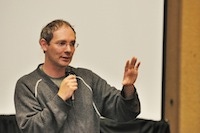Oracle Linux: The Past, Present and Future Revealed
When Oracle CEO Larry Ellison started poking around the Linux market way back in 1998 or so, he turned to Wim Coekaerts for help. Fast forward to the present, and more than 8,500 customers run Oracle Linux. But how did Oracle get to this point? And what's next for Oracle Linux and the Unbreakable Enterprise Kernel?
April 19, 2012


wim_coekaerts
When Oracle CEO Larry Ellison started poking around the Linux market way back in 1998 or so, he turned to Wim Coekaerts for help. Fast forward to the present, and more than 8,500 customers run Oracle Linux. But how did Oracle get to this point? And what’s next for Oracle Linux and the Unbreakable Enterprise Kernel? The VAR Guy tracked down Coekaerts and gained some candid insights — plus some strong opinions about Red Hat, SUSE, Ubuntu and even Cisco Systems. Here’s the update.Visit Oracle’s Redwood Shores, Calif., headquarters and you’ll be surrounded by a sea of suits — sales professionals and customer support experts who deal with CIOs and corporate customers. But poke around and you’ll find the blue-jeans-wearing developers and engineers who design Oracle’s products. That’s where Coekaerts fits in.
Down to earth and soft-spoken, Coekaerts doesn’t own a suit but Oracle still puts him in front of customers because he talks their language: Scalability, reliability, security, performance.
Getting Started
Coekaerts arrived at Oracle Belgium in 1995, right out of school, before moving to California. He has never worked anywhere else. By the late 1990s, Ellison tapped Coekaerts to assist on the New Internet Computer, a Linux-based appliance that flopped and died.
But the Linux experiment wasn’t a waste of time. Oracle also began looking at Linux opportunities on the server — mainly to make sure Windows NT Server did not dominate the market. “It’s pretty well known we don’t like Microsoft,” said Coekaerts. “We didn’t want Windows to be the x86 server standard, and Larry [Ellison} knew x86 was going to be important. Larry rocks. We have a great leader.”
Oracle’s first big Linux move on the server came in 1998, when Oracle ported its database to Linux two weeks before Informix (now owned by IBM) made a similar move. “We heard what Informix was up to and we had to beat them,” recalls Coekaerts. “We did.”
Oracle’s first call more than a decade ago was to SUSE, but a relationship never materialized, said Coekaerts. The next call was to Red Hat. The goal was to make sure Oracle applications delivered screaming performance on Linux servers. Plus, Oracle wanted to map Unix’s best features over to Linux. And Oracle wanted Red Hat to address bugs and issues that potentially limited Oracle application performance on Linux.
Oracle and Red Hat began working together, but Coekaerts claims Red Hat didn’t hold up its end of the bargain. Hence, Oracle created Oracle Linux — not necessarily to compete with Red Hat, Coekaerts says. Instead, to give customers one throat to choke when it came to running Oracle applications, databases and middleware on Linux.
Coekaerts also attended kernel-oriented Linux events and asked for enterprise features to be built into Linux. “But Linus [Torvalds] would say ‘do it yourself.'”
Big Moves
Oracle ultimately responded with its own, Red Hat-compatible Linux (Oracle Linux) and Unbreakable Enterprise Kernel. While some pundits allege Oracle has been out to destroy Red Hat, Coekaerts said otherwise.
“Our customers need bugs fixed and Oracle’s software fully tested on Linux. That’s why we went and did Oracle Linux. Red Hat has zero Oracle [software] knowledge, whether it’s development, QA or support. They couldn’t help our customers. So we introduced Linux support to help our customers.”
So far, roughly 8,500 customers run Oracle Linux and/or the Unbreakable Enterprise Kernel, up from about 7,100 customers last year.
Inflection Points
Asked to pinpoint Oracle’s key milestones with Linux, Coekaerts pointed to:
2002, when Oracle made a big commitment to Linux
2005, when Oracle’s customers really started to run Linux. Key adopters included Amazon. “I was on the phone every Friday [with Amazon] to help them with issues.”
2006: The big Oracle Linux launch that countered Red Hat
2007: Oracle VM joins the effort, giving Oracle a “full software stack” that’s all tested together.
2009: Oracle’s buyout of Sun, which begins the theme of engineered systems — hardware and software working together.
2011: The Ksplice acquisition, which allows Oracle Linux users to enable hot kernel patching. “Ksplice involved MIT folks. You can do online kernel updates without rebooting. It’s unique; nobody else on the planet is doing that right now.”
Ironically, Coekaerts concedes that the Oracle-Sun deal briefly “put a damper” on Oracle’s Linux efforts. “Some customers worried we would drop SPARC Solaris. Others worried we would drop Linux. We didn’t take either of those steps.” Gradually, Coekaerts said, customers realized Oracle was committed to both operating systems (Solaris and Linux), and Oracle Linux deployments have continued to enjoy “good, double-digit growth rates,” he said.
Random Thoughts
During our conversation, Coekaerts touched on a range of additional topics — such as:
Oracle Linux vs. SUSE Linux: “SUSE is gone; we don’t see them in the market anymore.”
Whether PC server makers (Dell, HP, etc.) will pre-install Oracle Linux: “They aren’t shipping it, but they are supporting it.”
On the Unbreakable Enterprise Kernel: “The kernel source is 100 percent open and every line of code is public.”
On Oracle Linux vs. Red Hat and CentOS: “We are as free and as open as CentOS.”
On Oracle’s own cloud/SaaS systems: “The majority runs on Linux.”
On Oracle’s Linux development strategy. “We spend 50 percent of our time making Linux a better operating system, and 50 percent of our time making Oracle run really well on Linux.”
On perceived competition with Red Hat. “We’re not really worried about Red Hat, but Red Hat does need a competitor. They are known to be arrogant. SUSE was a competitor with Red Hat but they lost their way.”
On Ubuntu and Mark Shuttleworth: “Ubuntu was not built to be a server product. They’ve tried to position for cloud servers, but ISVs have written applications for a particular platform — and it isn’t Ubuntu. The ISV world isn’t going to start testing on Ubuntu.”
On software appliances. “ISVs can not bundle Red Hat or SUSE with their software appliances; they would need support subscriptions [from Red Hat or SUSE] to do so. CentOS is one potential alternative to bundle but that offers no support. Oracle Linux is the only truly free option; ISVs can embed Oracle Linux [with their software appliances.”
Oracle, by the way, calls the software appliances “templates.” So far, Oracle has about 120+ templates but “we need to do an effort” to promote the template concept to ISVs, he added.
On multi-vendor vs. single-vendor solutions. “Around 2002 or 2003, companies wanted one vendor to deal with. Then it went multi-vendor. Now we’re getting back to customers wanting just one vendor because it’s all about cost savings. And we’re low-cost.”
On potential synergies and code sharing between Solaris and Oracle Linux. “They are separate organizations but we have a great relationship. When I meet with customers I tell them I’m here to talk about Linux. But Oracle supports and invests in both Linux and Solaris. We give customers choice.”
On Cisco’s UCS (Unified Compute System) and server strategy. “It’s pretty popular. It’s interesting. I’m surprised to see them have the amount of installs [reported].” But, he asserts, UCS is proprietary because you can only plug Cisco’s own blades into Cisco’s blade centers.
On OpenStack, cloud computing and virtualization: “Everyone thinks the cloud is about virtualization. But the cloud is an application delivery mechanism, not a virtualization story. And now we hear about OpenStack, but OpenStack is about providing VMs. We’re about delivering an eBusiness suite.”
Admittedly, this blog entry doesn’t give equal time to many of the companies Coekaerts mentioned. But that’s the beauty of a blog like The VAR Guy — we’ll be back with continuing coverage of all the key players.
Final Thoughts
In the meantime, Coekaerts made an impression on The VAR Guy. Employees within big technology companies often filter their words or use slick marketing presentations when sitting down with the media. Coekaerts showed up to our meeting with no safety nets, no presentations — and no filters.
Refreshing.
About the Author(s)
You May Also Like


